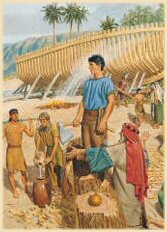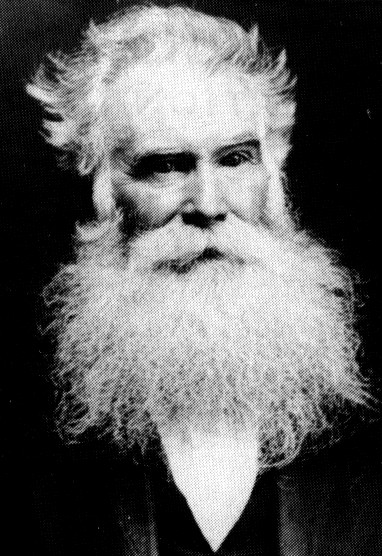

Anachronism in the Book of Mormon?
[Two Places at the Same Time 8 Years Apart]
prepred by Don R. Hender
Jeremiah 592 B.C.
~ Nephi WAS NOT in two different places at the same time [Book of Mormon time] ~
Nephi 584 B.C.
If true, a most most glaring anachronism in the Book of
Mormon would be if Nephi were in two places at about the same time, eight years apart.
Simply in truth, this cannot be because for a good number of years now I no longer question
anything in the Book of Mormon because I have to accept it as the absolute true ot God's word.
It is impossible even for Nephi to do, and yet to some there it is, Nephi is in the wilderness
bring back the daughters of Ishmael to the valley of Lemuel at the same time Nephi is in the
first land of Bountiful building a ship. By what is in the Book of Mormon today, it can be
presented just that way. An error? A mistake? Yes. But just what kind of anachronism error
is it. That is, what exactly causes it to exist in the pages of the Book of Mormon and is there
any possible and acceptable explanation that allows the truth of the Book of Mormon to still
be in tact despite of it?
Remenber the title page of the Book of Mormon warns the reader NOT to be critical of the Word
of God because of the mistakes or errors of men. Avoid 'becoming subject to the judgment of
Christ at the time of one's appearance at the Judgment-seat of Christ' due to mere human error.
Now this frequently attacked anachronism is criticized due to the ignorance
of the 'quick and dirty' reader of the Book of Mormon who does not read
completely with comprehension and understanding just what it is that he is
reading. Thus I will explain just how the anachronism was created by the
'well intended mistake or error of men' and how it is easily understood and
resolved to not be an error in the translation of the Book of Mormon and thus
it does NOT prove the Book of Mormon to be 'false'.
In 1 Nephi 7, the sons of Lehi have returned to Jerusalem to seek to obtain
the family and daughters of the family of Ishmael to become the wives of the
bachelor sons of Lehi. In short, the family of Ishmael agree to join with
Lehi's party in the wilderness. But on the trek back from Jerusalem to the
wilderness valley of Lemuel, there is a rebellion which involves Laman and
Lemuel and the two sons of Ishmael determining that they do not want to leave
Jerusalem after all. In the course of this 'argument' Nephi reminds his brothers
 and the sons of Ishmael that the current state of events in Jerusalem are not
the best set of conditions. And in support of which, the abridged record cites the
fact that even at this very time the Jews have taken the prophet Jeremiah
and placed him in prison (1 Nephi 7:14). A noteable Book of Mormon scholar in
his own right, Apostle Orson Pratt, in cross-referencing the Book of Mormon
record with that of the Bible seems to correctly cross-reference this
imprisonment of Jeremiah with that imprisonment recorded in the Bible in
Jeremiah 37:15 (15-18), where it records that the Jewish ruling 'princes' or
'sarim council of seventy' had been wroth with Jeremiah and had placed him
in the prison in the house of Jonathan the scribe. As any Biblical scholar
who is worth his salt will tell you, this was about the time of the eighth
year of the reign of King Zedekiah and about the time when the Babylonians had
come to place Jerusalem under seige but in the short interim they had to engage
and faced off with the Egyptians in the desert before again returning to their
planned seige of Jerusalem. In Book of Mormon reported time* this would have
been about 592 B.C. Now remember according to 1 Nephi 7, Nephi is contending
in the wilderness between Jerusalem and the valley of Lemuel with Laman, Lemuel
and the sons of Ismael over their desire to return to Jerusalem at about 592 B.C.
according to Apostle Orson Pratts Book of Mormon and Bible cross-reference of
1 Nephi 7:14 with Jeremiah 37:15. That is in today's Book of Mormon.
and the sons of Ishmael that the current state of events in Jerusalem are not
the best set of conditions. And in support of which, the abridged record cites the
fact that even at this very time the Jews have taken the prophet Jeremiah
and placed him in prison (1 Nephi 7:14). A noteable Book of Mormon scholar in
his own right, Apostle Orson Pratt, in cross-referencing the Book of Mormon
record with that of the Bible seems to correctly cross-reference this
imprisonment of Jeremiah with that imprisonment recorded in the Bible in
Jeremiah 37:15 (15-18), where it records that the Jewish ruling 'princes' or
'sarim council of seventy' had been wroth with Jeremiah and had placed him
in the prison in the house of Jonathan the scribe. As any Biblical scholar
who is worth his salt will tell you, this was about the time of the eighth
year of the reign of King Zedekiah and about the time when the Babylonians had
come to place Jerusalem under seige but in the short interim they had to engage
and faced off with the Egyptians in the desert before again returning to their
planned seige of Jerusalem. In Book of Mormon reported time* this would have
been about 592 B.C. Now remember according to 1 Nephi 7, Nephi is contending
in the wilderness between Jerusalem and the valley of Lemuel with Laman, Lemuel
and the sons of Ismael over their desire to return to Jerusalem at about 592 B.C.
according to Apostle Orson Pratts Book of Mormon and Bible cross-reference of
1 Nephi 7:14 with Jeremiah 37:15. That is in today's Book of Mormon.
 Now another notable Book of Mormon
scholar, Elder George Reynolds of the Seventy, had undertaken the laborious task of
calculating a 'suggested' timeline dating of the Book of Mormon. According to the Book of Mormon,
Lehi's family first depart Jerusalem, having been warned of the Lord of the Jewish leaders', the
Sarim, effort to put Lehi to death for preaching that Jerusalem would be destroyed if the Jews
would not repent. The Book of Mormon reports that Lehi's initial party departed Jerusalem in the
first year of the reign of King Zedekiah, which it states was 600 years before the birth of Jesus
Christ Book of Mormon time*. In Elder Reynolds compilation of a suggested time line he simply
takes the scripture found in 1 Nephi 17:4 it states that Lehi's party had completed an eight year
sojourn in the wilderness before they arrived at the place they wouldl call Bountiful and where
Nephi would build a ship. Elder Reynolds makes the very simplified calculation of taking 8 years
journey in the wilderness and he subtracts it from Lehi's departure date from Jerusalem of about
600 B.C. Book of Mormon time*. Thus he arrives with a suggested date of 592 B.C.
for when Lehi's party entered the place they called Bountiful where Nephi would build a ship. Now another notable Book of Mormon
scholar, Elder George Reynolds of the Seventy, had undertaken the laborious task of
calculating a 'suggested' timeline dating of the Book of Mormon. According to the Book of Mormon,
Lehi's family first depart Jerusalem, having been warned of the Lord of the Jewish leaders', the
Sarim, effort to put Lehi to death for preaching that Jerusalem would be destroyed if the Jews
would not repent. The Book of Mormon reports that Lehi's initial party departed Jerusalem in the
first year of the reign of King Zedekiah, which it states was 600 years before the birth of Jesus
Christ Book of Mormon time*. In Elder Reynolds compilation of a suggested time line he simply
takes the scripture found in 1 Nephi 17:4 it states that Lehi's party had completed an eight year
sojourn in the wilderness before they arrived at the place they wouldl call Bountiful and where
Nephi would build a ship. Elder Reynolds makes the very simplified calculation of taking 8 years
journey in the wilderness and he subtracts it from Lehi's departure date from Jerusalem of about
600 B.C. Book of Mormon time*. Thus he arrives with a suggested date of 592 B.C.
for when Lehi's party entered the place they called Bountiful where Nephi would build a ship.
Simply stated, Nephi cannot be in two places at the same time. Superman can. Nephi cannot. Nephi
cannot be between Jerusalem and the valley of Lemuel arguing with his brothers and the sons of
Ishmael about returning to Jerusalem and using the fact of Jeremiah being imprisoned about the
Book of Mormon date* of 592 B.C. 'AND' also at the location of Bountiful building a ship at about
592 B.C. as well. That would be a case of an anachronism of time that would not be humanly possible.
That is being in two different places at the same time several years apart. 'BUT NOTE' it is
not the Book of Mormon itself that has caused this anachronism situation. It is the well
intended scholarly work Orson Pratts' placement of the cross-reference of 1 Nephi 7:14 to Jeremiah
37:15 'AND' Elder George Reynold's well intended calculations of a 'suggested' Book of Mormon
timeline of dates schedule that has caused the anachronism to exist.
And today's Book of Mormon still contains both, Apostle Orson Pratts' cross-reference and Elder
George Reynolds' suggested timeline dates. And thus there is an error in the Book of Mormon caused
by the fault and mistake of men. In this case men post the translation of the Book of Mormon
whose efforts are both still published in today's Book of Mormon, yet unresolved. As somewhat
of a Book of Mormon scholar myself, though not of the position of a general authority such as
Apostle Orson Pratt or Elder George Reynolds of the Seventy, I do have what I think is the correct
solution that would resolve this Book of Mormon 'error' of an anachronism of time.
My solution is to revise Elder George Reynold's suggested timeline dates, at
least that early portion involving Lehi's time spent in the valley of Lemuel
and just when Lehi did journey for 8 years in the wilderness to the location
called Bountiful where Nephi built the ship. Simply, Elder Reynolds' quick
accessment that the 8 years travel in the wilderness to Bountiful recorded
in 1 Nephi 17:4 was from the time Lehi left Jerusalem of 600 B.C., is not
correct. What it was, is that it marked the time from when Lehi's party, joined by Ishmael's
family and after the relative marriages of the corresponding families' sons and daughters,
that is, it is from the valley of Lemuel to the location of Bountiful, that was the 8 year
journey. This would mean that Lehi had lived with his family in the valley of
Lamuel for about 7-8 years or so, since his departing Jerusalem. That is about 600 B.C. to
592 B.C. Book of Mormon time*. And then after being joined by the family of
Ishmael and the marriage of their sons and daughters, Lehi's now combined
and enlarged party departed the valley of Lemuel about 592 B.C. to about
584 B.C., thus traveling the reported 8 years journey in the wildernes from
the valley of Lemuel to their arrival at the place called Bountiful.
That adjustment in Elder Reynolds 'suggested' timeline would resolve the
'anachronism error' with no fault noted to the Book of Mormon translation,
but wholely assigned to the fault and mistakes of men. The sad fact is that
any well intended student of the Book of Mormon could/would just this easily
resolve the seeming anachronism. Only an ill spirited and mean intentioned Mormon
hating critic would attempt to use such as this honest mistake of men to
teardown and malign another's religion and faith, especially when being so poorly
informed and poorly studied in the Book of Mormon text itself. And thus the real big
loser here is that likely dishonest, ill intentioned Mormon critic who just
is set about the work of destroying others with his lies and his hatred of his
fellow man.
*Note: Whereas the Book of Mormon places the first year of the
reign of Zedekiah to be about 600 B.C., there is about a 3 year difference
with the 'calculated' time schedules of men who place that date at about 597 B.C.
Thus note is made that it is the Book of Mormon given dates which are used
here in speaking of the supposed Book of Mormon Anachronism rather than the
dates of men so assigned to the events of the Bible. A three year difference
in the scheme of such calendar developments and adjustments and the accountings
of error prone human men is not worth the effort to investigate this
difference further other than to merely note it as having been given.
Addendum
Sometimes appearances are not what they seem. In connection with the 1920-21 edition
of the Book of Mormon, that was the long standard standing edition with only a few
minor adjustments, it ought to be pointed out what was and was not. Elder James E.
 Tamage of 'Jesus the Christ'' famed text published by the Church of
Jesus Christ was the Apostle tasked with leading a review and update the Book of Mormon
variously, including discription headings, modernizing the texted into double columns,
chapter summaries, and further footnotes additions and changes and some minor editing
did continue in this edition as were in the 1905 and 1911 edition that were also under
the editorship of Elder Talmage.
Tamage of 'Jesus the Christ'' famed text published by the Church of
Jesus Christ was the Apostle tasked with leading a review and update the Book of Mormon
variously, including discription headings, modernizing the texted into double columns,
chapter summaries, and further footnotes additions and changes and some minor editing
did continue in this edition as were in the 1905 and 1911 edition that were also under
the editorship of Elder Talmage.
One removed footnote was that which stated that the Sidon river was 'supposed' as be the
Magdalena river (Alma 2:15). That footnote, was likely placed in the text relative to Elder
Reynold's scholarship, and it was still in my Grandfather's 1905/6 edition of his single
column triple combination he used on his mission to England in 1907-1909. Since Elder Talmage
did go through the footnotes, adding and deleting, including the installation of the 'suggested'
timeline dates placed as part of the footnotes on each page, and though they were adapted
'wholesale' from Elder George Reynold's scholarship, many have considered it was Elder Talmage's
own scholarship that provided those dates.
And today, if you go online to the LDS Church web site and find the Book of Mormon scriptures,
you will actually see those same suggested dates from Elder George Reynolds placed prominantly
at the end of each chapter's editorized headings. Now those headings do aid in one's study
of the Book of Mormon and they do serve their purpose, but the evolution of the prominence of
Elder Reynold's devised timeline dates is of interest to follow.
|



